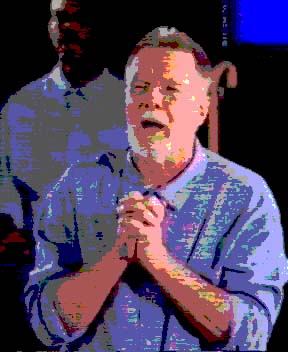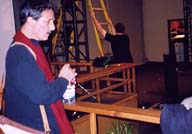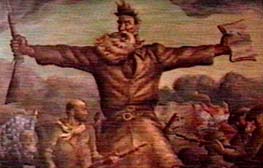It was Wednesday night. We had just finished our first day of setup with a short rehearsal in a space in San Quentin prison where John Brown’s Body was scheduled to open on Thursday night, the next day! It was a little after 9:00pm ( a prison deadline) and that’s all the time we had. No typical dress-rehearsal-night filled with nerves and exhaustion and stimulants. No all-night session blues. We were out of there and there was no discussion. I had to ride with the two-ton white sound truck in order to get to my car on the other side of the prison and through the gate that I had entered. There was the sound engineer, Phil Edwards, me, and a young, nervous guard. It was deadline-quiet, bright-lit, and Bay Area cold.
When we pulled up to the razor-wired double gate, between two tight walls, we saw no one. A large sign demanded that we turn off the motor and get out. None of us knew what to do, especially our escort. The young, nervous guard slowly stepped out of the truck, checked the office next to the gate, then hopped back in and told Phil to back up and stop. He also told us he was new and wasn’t sure what was happening. Thank you. So we backed up and sat there surrounded by bright lights, narrow walls, gun towers, and cold silence. Suddenly, a bullhorn voice yelled: “Get out of the truck!” A long moment and then Phil rolled out of his door, the guard jumped out of his, and I slouched in the seat. The voice again: “Get out of the truck!” That’s what I did! We all just stood there by the truck. If you want a surrealistic definition of the word “naked”, that was it. Then three other guards appeared, escorted us to the office and checked every box and every cavity in the truck (understandable -- this was, after all, San Quentin, a high security prison).
They couldn’t find me on the check-in list. They took all of my ID and began calling other posts. No one could find my name in the computer until an off-duty guard at the main gate compassionately took another look. After some long, anxious minutes, I was cleared to leave. As he handed me my precious identity, the guard un-laughingly remarked: “It’s a good thing he hadn’t gone home yet. Otherwise, you’d be... who knows!” That capped the day!
Later, as I drove across the moon-swept Golden Gate Bridge away from the moon-swept San Quentin prison, I thought: That jittery little incident was an icon of the whole process. It had nothing and everything to do with theatre and film and the staging of this production.
John Brown’s Body At San Quentin should not have made it into production, into performance, into film. There was no money, no theatre, and little understanding of the process by prison officials. But it did... make it, because of the writing of Stephen Vincent Benet, the vision and gutsy mania of Joseph De Francesco, and the talent of production artists who invested their time and work because it was a good project and it had to be done.
|
To recount the three years that led to the astonishing performances and filming would take 10 volumes of this magazine. But as with the production itself, it is a nearly incredible story that must be told. A companion documentary is in the works which will do just that. I don’t know anyone else except De Francesco (and not to forget his wife, Marie-Pierre) who could have tolerated, absorbed, recovered and “kept on” in the paranormal, unforgiving world of a high-security prison like San Quentin. If Dante were writing now, he would have created a “ring” solely for De Francesco’s experiences.
In August of last year, just at a point where it seemed that the stonewall was becoming a deep pit, it all changed. This is what happened:
PBS’s “News Hour” decided to do a piece on the JBBSQ project. Spencer Michaels brought in a crew for a special rehearsal-performance of the first part of the play. Some outside guests were invited, and the Warden and other prison officials (for the first time) came to take a look. What they saw spurred this response: “So that’s what it’s all about. It’s great!” A few weeks after the story was broadcast in the U.S. and overseas, the prison administration declared: “We have to have a show! November 1st.” Six weeks! And there was no way to change the date. Six weeks for what usually takes three months or more to prepare.
Let the future documentary tell you about the madness tempered with delightful good fortune that painted the five weeks prior to production rehearsals. Among the manna that fell -- top audio producer, Andy Wiskes, threw in for the ride, as did noted Hollywood cinematographer Hiro Narita, conductor and film composer Arthur B. Rubenstein, Judy Flannery, a highly respected producer of stage and television, and me... there were others (see Credits). Here’s what we faced:
The “theatre” (the only prison space available) was a chapel with a low altar-platform;
The chapel supervisor was unhappy and only gave reluctant approval ;
The space was totally unequipped for a production like this, inadequate power,
ceiling height, sight lines, tech areas;
Nothing could be changed or moved in the space;
Nothing could be attached to the walls or ceiling (even with tape);
No work, no rehearsals in the space until the day before the opening;
When the actors (inmates) or other inmates were in the space
all ladders, all tools had to be removed and locked away;
No props, other than a few chairs, a few pieces of cloth, a few canes;
No costumes other than “dress” prison blues;
Every piece of equipment, cable, tool had to be checked and cleared;
Every production person had to be checked and cleared;
And... no female actors on stage with the 10 male inmate-actors!
This last restraint almost ended the project. Inherent to the staging of Benet’s work is a core of three actors two male, one female - the woman portraying 14 roles, In his adaptation, De Francesco expanded the core to ten actors and moved away from a staged reading toward a fully staged performance. So he began to experiment with merged-media in an effort to climb over this huge stone in the wall. He solved the sans-female problem: he filmed actress, Blancett Reynolds, in timed portrayals of the roles and then merged his “virtual actress” as a projection on stage with his ten live actors. The result was more than an expedient answer to a nightmarish obstacle -- it became a powerful enhancement to the performance itself.
The answer to the rest of the wall of stones was to treat the “theatre” as a touring location. Everything had to be self-contained - the power, the set, the technical structure. We had to create a performance box and insert it into the space. All in a day and a half.
 |
Editors’ Note à la redux... this article originally appeared in the January 2003 issue of Scene4. Though it currently resides in the Archives, the continuing expansion of the readership prompted the redux publication of the story of this unique merged-media event. There are a few minor changes to the original and a hint at the future of the production as it makes its way to the screen.
© 2003 AVIAR-DKA Ltd. All rights reserved (including authors’ and individual copyrights as indicated). All copyrights, trademarks and servicemarks are protected by the laws of the United States and Internalnational laws. Reproduction in whole or in part without permission is prohibited.
For permissions, contact publishers@scene4.com
All articles are archived on this site.
To access the Archives

SEPTEMBER 2003







